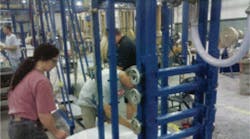Gary Weber recites an enviable metric: 1%. That's the percentage of production time lost to unplanned equipment breakdowns at Laminations' Appleton, Wis., manufacturing plant, estimates the company's vice president of manufacturing. Laminations manufactures edge protectors made from recycled paperboard, used as protective packaging for shipping.
The 1% is a good metric, but it didn't tell the entire maintenance story at Appleton in early 2011. "When we dug deep, we found that at times operators were continuing to operate equipment at less-than-optimum conditions," with needed maintenance being deferred or delayed, Weber said. When those situations occurred, productivity would dip and waste would increase.
While the issue may not have qualified as a maintenance nightmare, it presented a maintenance improvement opportunity. So, too, did a 5S program (workplace practices centered on cleanliness) that had not achieved hoped-for gains.
But that was then. To resolve the dual issues, Laminations in July 2011 introduced TPM, or Total Productive Maintenance into its 100,000-square-foot Appleton plant. Early signs show promising returns.
Kaizen Event Launches TPM
TPM is a comprehensive program to maximize equipment reliability and availability in which -- among other components -- production operators are trained to perform routine maintenance tasks on a regular basis, while technicians handle more specialized tasks. It is tightly aligned with lean manufacturing.
"One of the things we needed in this facility to make things stick was some structure," Weber explains. "TPM gives you that structure."
In July Laminations held its first kaizen event to implement TPM on one of three production lines in the facility. Weber specifically chose the middle line for the initial effort. "The reasoning was it would be visible to the other people in the plant. They could see what was going on and be curious," Weber says. "We wanted to see if we could get momentum going."
Training preceded the kaizen event, as did several months of preparation. "We didn't spring it on them all at once," explains Doug Bengson, continuous improvement guide at consulting firm Headwaters Excellence Partners. Headwaters assisted Laminations in its first kaizen effort. During the preparation, team members discussed issues surrounding maintenance, at the same time "taking pains not to point fingers," Bengson says.
Demonstrate Upper-management Support
Kaizen participants included line operators, maintenance technicians, the plant manager and several others, Weber participated as well. "It was important to show that there is support from upper management," he explains. "The way to do that is to get involved. Get in there and get dirty with them."
They got dirty. The kaizen event began with a deep clean of the equipment, which in places was covered with hardened layers of the glue used to manufacture Laminations' V-shaped edge protectors. Kaizen participants stripped equipment down to bare metal, repainted it where necessary and largely restored machinery to like-new condition.
The kaizen event also began the process of implementing improved structure around maintenance activities, although work continued well beyond the event's completion. "We came away with a laundry list of things we had not finished," Weber says.
Today the structure includes visual controls for the machinery. The visual signals identify areas that require regular attention, such as lubrication points and gauge set points. The structure also includes a checklist of routine maintenance activities operators perform daily, weekly or monthly, as well as standards for TPM audits by supervisors.
Perhaps the biggest boost to providing structure, however, was the introduction of a system to manage maintenance work orders, Weber says. The kaizen team developed a routing system for the work orders, as well as a schedule by which they must be completed. The work orders are posted and visible, allowing everyone to track their status.
"Before [work orders] kind of went into a black hole, and there were three or four different routes they could travel," Weber says. "Things are getting fixed now instead of just lingering. That is happening."
Early Signs Indicate Staying Power
The TPM initiative is less than a year old on one production line. A kaizen event to implement TPM on a second production line recently was completed. Weber says the second kaizen went more quickly than the initial one did because operators there already had "upped maintaining their equipment" after observing efforts on the earlier event.
With TPM so recently implemented, Weber hesitates to provide any hard numbers as evidence the solution is working. But he believes it is. Housekeeping is much improved due to the daily attention it receives.
"I think the biggest positive is that the operators have taken some ownership in helping to maintain the machines. The other positive is that we have put in predictive and preventive measures, so we are not waiting for [equipment] to break down before we fix it," Weber says. "We've got everybody from the operators to the maintenance people engaged in maintaining the equipment."
See Also:
Six Keys to an Effective Lubrication Program
Five Common Lean Maintenance Missteps
Lean for Machines





